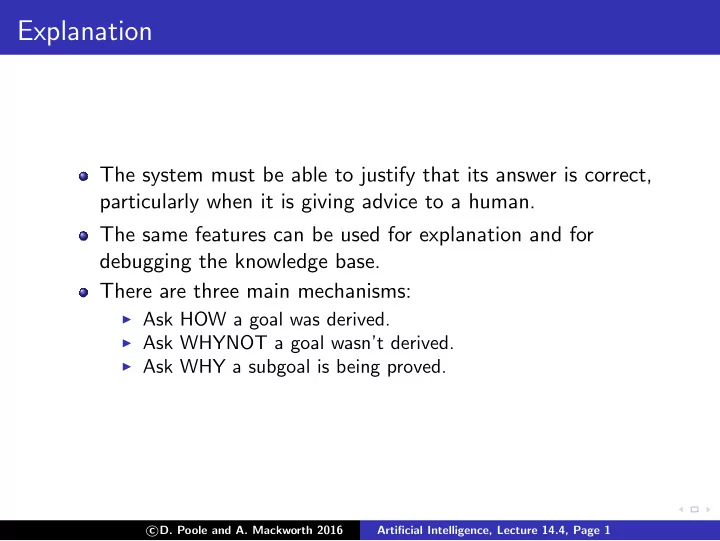

Explanation The system must be able to justify that its answer is correct, particularly when it is giving advice to a human. The same features can be used for explanation and for debugging the knowledge base. There are three main mechanisms: ◮ Ask HOW a goal was derived. ◮ Ask WHYNOT a goal wasn’t derived. ◮ Ask WHY a subgoal is being proved. � D. Poole and A. Mackworth 2016 c Artificial Intelligence, Lecture 14.4, Page 1
How did the system prove a goal? If g is derived, there must be a rule instance g ⇐ a 1 & . . . & a k . where each a i is derived. If the user asks HOW g was derived, the system can display this rule. The user can then ask HOW i. to give the rule that was used to prove a i . The HOW command moves down the proof tree. � D. Poole and A. Mackworth 2016 c Artificial Intelligence, Lecture 14.4, Page 2
Why Did the System Ask a Question? It is useful to find out why a question was asked. Knowing why a question was asked will increase the user’s confidence that the system is working sensibly. It helps the knowledge engineer optimize questions asked of the user. An irrelevant question can be a symptom of a deeper problem. The user may learn something from the system by knowing why the system is doing something. � D. Poole and A. Mackworth 2016 c Artificial Intelligence, Lecture 14.4, Page 3
WHY question When the system asks the user a question g , the user can reply with WHY This gives the instance of the rule h ⇐ · · · & g & · · · that is being tried to prove h . When the user asks WHY again, it explains why h was proved. � D. Poole and A. Mackworth 2016 c Artificial Intelligence, Lecture 14.4, Page 4
Debugging Knowledge Bases There are four types of nonsyntactic errors that can arise in rule-based systems: An incorrect answer is produced; that is, some atom that is false in the intended interpretation was derived. Some answer wasn’t produced; that is, the proof failed when it should have succeeded, or some particular true atom wasn’t derived. The program gets into an infinite loop. The system asks irrelevant questions. � D. Poole and A. Mackworth 2016 c Artificial Intelligence, Lecture 14.4, Page 5
Debugging Incorrect Answers An incorrect answer is a derived answer which is false in the intended interpretation. An incorrect answer means a clause in the KB is false in the intended interpretation. If g is false in the intended interpretation, there is a proof for g using g ⇐ a 1 & . . . & a k . Either: ◮ Some a i is false: debug it. ◮ All a i are true. This rule is buggy. � D. Poole and A. Mackworth 2016 c Artificial Intelligence, Lecture 14.4, Page 6
Debugging Missing Answers WHYNOT g . g fails when it should have succeeded. Either: ◮ There is an atom in a rule that succeeded with the wrong answer, use HOW to debug it. ◮ There is an atom in a body that failed when it should have succeeded, debug it using WHYNOT. ◮ There is a rule missing for g . � D. Poole and A. Mackworth 2016 c Artificial Intelligence, Lecture 14.4, Page 7
Debugging Infinite Loops There is no automatic way to debug all such errors: halting problem. There are many errors that can be detected: ◮ If a subgoal is identical to an ancestor in the proof tree, the program is looping. ◮ Define a well-founded ordering that is reduced each time through a loop. � D. Poole and A. Mackworth 2016 c Artificial Intelligence, Lecture 14.4, Page 8
Recommend
More recommend